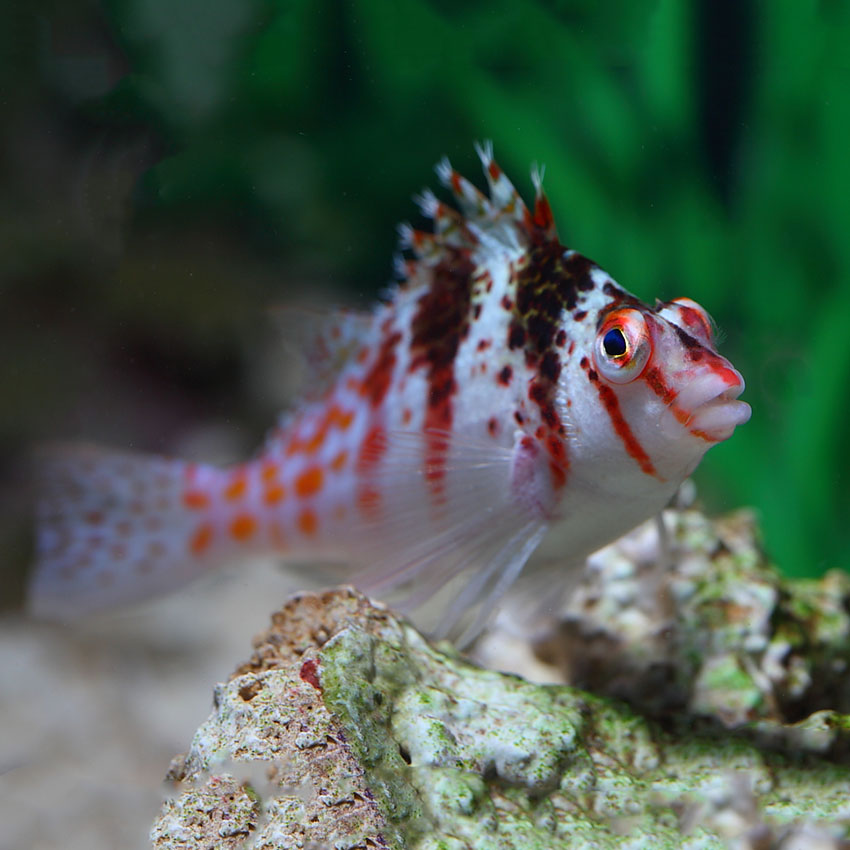The Falco Hawkfish (Cirrhitichthys falco) has a distinct and captivating appearance. It features a cylindrical body with a maximum size of around 4 inches (10 centimetres). They have a large head with a downward-curved mouth and prominent eyes. Their body can display shades of red, orange, and brown, often in intricate patterns and markings. Their dorsal fin is elongated and stands upright, adding to their unique and charismatic look.
Taxonomy:
The Falco Hawkfish, scientifically known as Cirrhitichthys falco, belongs to the family Cirrhitidae. It is classified under the order Perciformes, which includes a diverse group of ray-finned fish species.
Natural Habitat:
In their natural habitat, the Falco Hawkfish can be found inhabiting coral reefs and rocky areas with ample hiding spots. They prefer areas with moderate to strong water movement. These fish are often encountered at depths ranging from 10 to 100 feet (3 to 30 meters). Their natural habitat is vibrant and rich with various coral formations and marine life.
Keeping the Falco Hawkfish Healthy:
The Falco Hawkfish requires moderate care and attention to thrive in a home aquarium. The care level is generally considered to be moderate, and they are suitable for intermediate to experienced marine fish keepers. Providing a well-maintained environment with stable water parameters is crucial for their well-being. It is recommended to maintain the water temperature between 72°F and 78°F (22°C and 26°C), and the pH level between 8.1 and 8.4. Regular water changes and a high-quality protein-rich diet are essential for their health.
Special Requirements and Feeding:
Falco Hawkfish are carnivorous and primarily feed on small crustaceans, copepods, and other small invertebrates in the wild. In a captive environment, they can be fed a varied diet consisting of frozen or live meaty foods, such as brine shrimp, mysis shrimp, and finely chopped seafood. Providing a varied diet helps ensure they receive proper nutrition and helps satisfy their natural hunting instincts.
How Many Should I Keep:
Falco Hawkfish are generally kept singly or in mated pairs. They are territorial and may exhibit aggression towards conspecifics and similar-looking fish. It is recommended to provide ample space and hiding spots if keeping more than one hawkfish in the same tank.
Lighting Preference:
Falco Hawkfish can adapt to various lighting conditions. They can be kept under moderate to high lighting in a reef aquarium. Providing sufficient lighting enhances the vibrant colours of their body and promotes the growth of photosynthetic organisms in the tank.
Suitable Tank Mates:
When choosing tank mates for the Falco Hawkfish, it is important to consider their territorial nature. They may display aggression towards smaller, peaceful fish or those with similar body shapes and coloration. It is advisable to avoid housing them with timid or slow-moving species. Suitable tank mates can include larger, more robust fish, such as other hawkfish species, angelfish, tangs, and larger wrasses.
Reproduction in the Wild: In the wild, the reproductive behaviour of the Falco Hawkfish (Cirrhitichthys falco) is not extensively documented. However, like other hawkfish species, they are presumed to be oviparous, meaning they reproduce by laying eggs. During the breeding season, which can vary depending on their natural habitat, male and female hawkfish engage in courtship rituals to initiate spawning.
Breeding Cirrhitichthys falco:
Breeding the Falco Hawkfish in a home aquarium is challenging and requires specialized knowledge and equipment. Here is a detailed overview of the breeding process:
- Set up:
Prepare a separate breeding tank with appropriate water conditions and equipment. The tank should have proper filtration, a stable temperature of around 78°F (26°C), and low lighting to simulate the natural environment.
- Courtship/Spawning:
Introduce a well-conditioned male and female hawkfish into the breeding tank. Provide suitable spawning sites, such as flat surfaces or coral branches, where the female can deposit her eggs. The male will court the female, displaying vibrant colours and performing courtship dances to encourage spawning. Once spawning occurs, the female releases her eggs, and the male fertilizes them externally.
- Rearing:
After spawning, it is crucial to remove the adult hawkfish from the breeding tank to prevent them from consuming the eggs. The eggs will hatch within a few days, and the fry will become free-swimming shortly after. At this stage, provide appropriate live foods, such as rotifers and copepods, to ensure the fry’s proper nutrition and growth. Regular water changes and monitoring water parameters are essential for their well-being.
Sexual Dimorphism:
Sexual dimorphism in the Falco Hawkfish is not significant, with males and females generally displaying similar physical characteristics and coloration. Therefore, distinguishing between the sexes based on external appearance alone can be challenging.
Distribution: The Falco Hawkfish, Cirrhitichthys falco, is naturally distributed across the Indo-Pacific region. They can be found in areas ranging from the Red Sea and East Africa to the Pacific Ocean, including locations such as the Maldives, Indonesia, and the Great Barrier Reef. While they are occasionally available as captive-bred specimens, the original wild fish are sourced from these regions.
Summary:
The Falco Hawkfish, scientifically known as Cirrhitichthys falco, is a visually captivating and engaging species that adds beauty to marine aquariums. With a moderate care level, they require a well-maintained environment, stable water parameters, and a varied diet of meaty foods. While they can be kept individually or in mated pairs, caution should be exercised when choosing tank mates due to their territorial nature. Breeding the Falco Hawkfish in captivity is challenging but can be achieved with the right setup, courtship rituals, and proper rearing techniques. These fish are naturally distributed across the Indo-Pacific region and are occasionally available as captive-bred specimens. With their unique appearance and behaviour, the Falco Hawkfish is a delightful addition to any marine aquarium.





Reviews
There are no reviews yet.